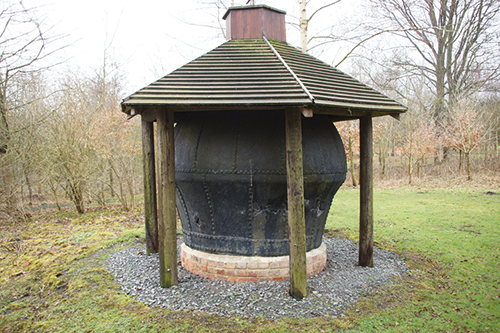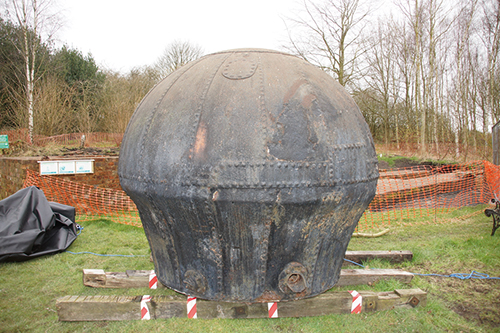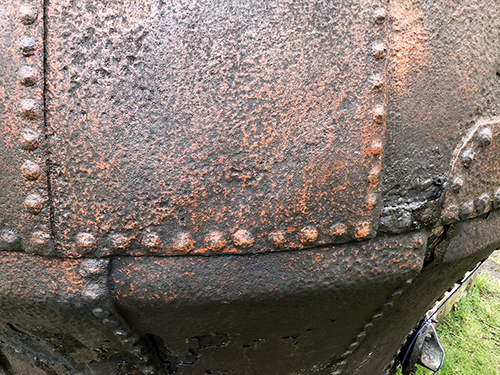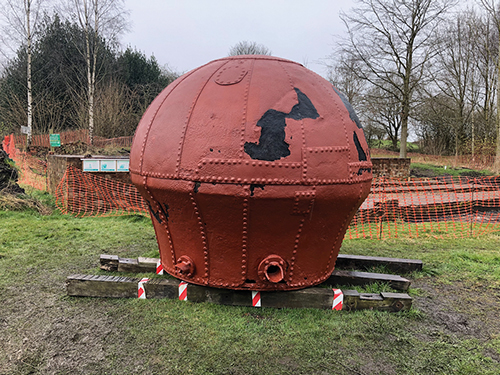Historic colliery boiler gets some TLC
 The Califat boiler in Swannington, Leicestershire, gets its name from its association with the Califat Colliery, also known as Coleorton No 2 colliery. It sits in the Califat Spinney to the north of the village and is of national significance. The boiler is a rare survivor of the first type of commercially successful steam engine, the Newcomen atmospheric engine. Only six are currently known to survive.
The Califat boiler in Swannington, Leicestershire, gets its name from its association with the Califat Colliery, also known as Coleorton No 2 colliery. It sits in the Califat Spinney to the north of the village and is of national significance. The boiler is a rare survivor of the first type of commercially successful steam engine, the Newcomen atmospheric engine. Only six are currently known to survive.
Introduced by Thomas Newcomen in 1712, they used condensed steam to create a vacuum, which allowed atmospheric pressure to force a piston down in an open cylinder. The piston was connected to a rocking beam that allowed a pump to lift water out of a mine. It was also known as a ‘haystack’ boiler due to its shape: circular with a domed roof and made of a series of overlapping riveted wrought iron plates. The top was partially covered with an opening left for a steam injection pipe, which is no longer present. The base had a slightly domed profile and there were the remains of two cast iron pipe connectors around the base line.
 After a period of time the boiler was used for water storage only, as no evidence for a hearth was found when it was ‘discovered’ in 1969 by industrial archaeologists on a field walking survey.
After a period of time the boiler was used for water storage only, as no evidence for a hearth was found when it was ‘discovered’ in 1969 by industrial archaeologists on a field walking survey.
The Leicestershire Industrial History Society excavated the boiler in the early 1970s and it was then donated to Leicestershire City Museums, where it was restored before being put on display. The ironwork was treated and painted on the outside with a bituminous coating and areas of wrought iron loss were filled with fibreglass patches.
In 1995 the boiler was transferred to the Snibston Discovery Park, where it was placed in storage before being loaned to the Swannington Heritage Trust in 2011. It was then placed on display close to the location where it was found.
Leicestershire County Council employed the Historic Metalwork Conservation Company to undertake a detailed condition report on the boiler in March 2018. A series of conservation recommendations were drawn up in order to stabilise the boiler for the short, medium and long term.
 It showed evidence of repairs during its earlier life, with later iron patches riveted over the original. The boiler was displayed outside, under a wooden roof structure supported on wooden uprights. While that prevented rainwater from getting inside the boiler, it only provided limited protection from the weather. As a result it showed evidence of on-going slow deterioration. The external paint coating was heavily degraded and there were accumulations of dirt and algae present on the surface. Rusting and metal losses had occurred around the cast iron pipe fittings, due to dissimilar metal corrosion. The glassfibre repair patches had deteriorated due to their age and some had become partially detached from the wrought iron surface.
It showed evidence of repairs during its earlier life, with later iron patches riveted over the original. The boiler was displayed outside, under a wooden roof structure supported on wooden uprights. While that prevented rainwater from getting inside the boiler, it only provided limited protection from the weather. As a result it showed evidence of on-going slow deterioration. The external paint coating was heavily degraded and there were accumulations of dirt and algae present on the surface. Rusting and metal losses had occurred around the cast iron pipe fittings, due to dissimilar metal corrosion. The glassfibre repair patches had deteriorated due to their age and some had become partially detached from the wrought iron surface.
Leicestershire’s senior curator and the Swannington Heritage Trust have embarked on a programme of conservation works to improve the preservation of this nationally significant boiler. They have begun by removing the boiler from under its wooden roof structure for display in a new location close by, under an improved roof covering. As part of this first phase, the Historic Metalwork Conservation Company was employed to carry out the recommendations for short-term conservation.
 The outside of the Califat boiler was cleaned down to remove dirt, algae, loose paint layers and corrosion back to a sound surface. That was carried out using wire brushes, scrapers and abrasive papers. Much of the degraded bitumen paint, which had shrunk and cracked extensively, was also removed.
The outside of the Califat boiler was cleaned down to remove dirt, algae, loose paint layers and corrosion back to a sound surface. That was carried out using wire brushes, scrapers and abrasive papers. Much of the degraded bitumen paint, which had shrunk and cracked extensively, was also removed.
The cleaned surface was then finally prepared by lightly abrading with fine Scotch-Brite pads. It has not been possible to clean the inside of the boiler at this stage due to the difficulties of accessing it safely.
Removal of much of the later bitumen coating revealed an underlying layer of red oxide, which was still providing some protection to the original iron surface. The small areas of rust present – particularly around the cast iron pipe fittings – were treated with a commercial rust converter, Loctite 7500. That was left to act for 24 hours. The outside of the boiler was then protected with two coats of Sherwin-Williams Kem-Kromik 155: a quick-drying, alkyd-based, anticorrosive protective finish containing zinc phosphate. That was applied using rollers and brushes and will provide on-going surface protection until the next phase of the conservation works can be carried out.
• For further information visit www.hm-cc.co.uk













